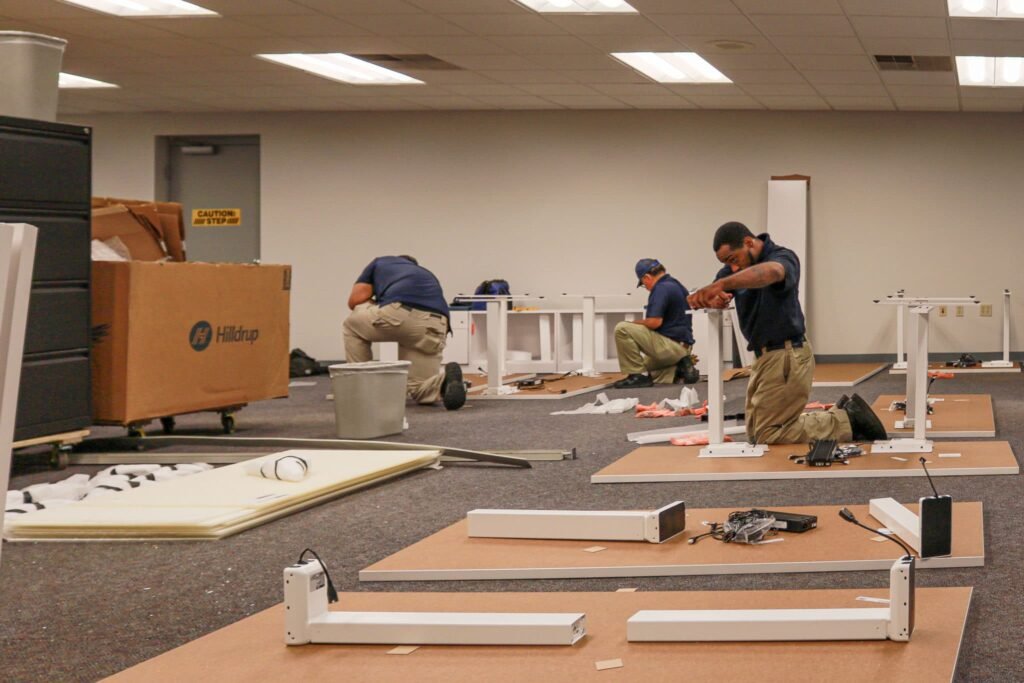Change is inescapable in the vibrant corporate world of today. For various reasons, including operational optimization, adjusting to market needs, or embracing new technical breakthroughs, businesses evolve, grow, contract, or migrate. Office decommissioning is one component of this organizational transformation that sometimes goes unreported. This necessary procedure calls for thorough preparation, implementation, and consideration of environmental effects; it goes beyond just packing up desks and turning out the lights. We’ll go through office decommissioning in this post, looking at its importance, processes, and advantages for businesses and the environment.
Defining Office Decommissioning
Office decommissioning, simply put, is the comprehensive process of closing down an office space or facility in a structured and sustainable manner. It goes beyond the physical act of removing furniture and equipment; it encompasses a range of tasks, from IT asset management to environmental responsibility, with the ultimate goal of minimizing disruption, maximizing asset recovery, and ensuring a seamless transition for employees and stakeholders.
The Significance of Office Decommissioning
Strategic Planning for Smooth Transitions
Office decommissioning is not a process to be taken lightly. When a company decides to shut down or relocate an office, the impact on employees, business operations, and the environment must all be carefully considered. A well-executed decommissioning strategy ensures that transitions occur with minimal disruption and maximum efficiency. It involves assessing the scope of the decommissioning, setting clear objectives, and creating a timeline that accounts for everything from equipment removal to lease termination.
Asset Recovery and Sustainability
One of the benefits of office decommissioning is the potential for substantial asset recovery. Furniture, electronics, and office equipment can represent an investment for companies. Rather than discarding these assets, decommissioning provides an opportunity to recover, reuse, or recycle them. It reduces financial losses and contributes to sustainability efforts by preventing unnecessary waste and lowering the demand for new resources.
The Office Decommissioning Process
Comprehensive Assessment
Before embarking on the decommissioning journey, a thorough assessment of the office space and its contents is crucial. It involves identifying valuable assets, determining items for disposal, and evaluating potential environmental hazards. It’s also an opportunity to create an inventory list to guide the rest of the decommissioning process.
Strategic Asset Management
As mentioned earlier, asset recovery is a significant aspect of office decommissioning. Valuable assets include office furniture, computers, servers, and architectural elements. Companies can sell, donate, or repurpose these items, recouping some of the initial investment, contributing to charitable causes, and minimizing environmental impact.
IT Asset Disposition (ITAD)
In this age of technological advancement, IT assets play a crucial role in business operations. Properly managing the disposal of computers, servers, and other electronic devices is essential for data security and minimizing electronic waste. IT Asset Disposition (ITAD) involves securely wiping data, refurbishing machines for reuse, and recycling electronic components in an environmentally responsible manner.
Environmental Responsibility
Sustainability is a global priority, and office decommissioning offers a chance for companies to demonstrate their commitment to environmental responsibility. Recycling e-waste, choosing energy-efficient solutions for equipment disposal, and opting for eco-friendly packaging materials are all ways to reduce the carbon footprint of the decommissioning process.
Benefits of Office Decommissioning
Minimized Disruption
In the realm of office decommissioning, one of the most crucial aspects is the art of minimizing disruption. The process of closing down an office space or relocating to a new one can be rife with challenges that have the potential to disrupt both business operations and the morale of employees. However, with meticulous planning and strategic execution, companies can ensure seamless transitions that mitigate these disruptions.
One of the primary goals of office decommissioning is to orchestrate the process in such a way that the daily operations of the business are affected as little as possible. It involves creating a comprehensive plan that considers the specific needs and requirements of the company. From timing the decommissioning process to coincide with periods of lower activity to ensuring that essential services are maintained throughout the transition.
Proper planning not only minimizes the disruption to business operations but also considers the well-being of employees. Employees are the heart of any organization, and their morale and productivity can be deeply affected by the uncertainties and challenges posed by office decommissioning. Companies can ensure that employees remain engaged and motivated despite the changes by providing clear communication, involving employees in the planning process where appropriate, and addressing their concerns and needs.
Moreover, strategic timing plays a significant role in minimizing disruption. The impact on day-to-day operations can be significantly reduced by carefully scheduling the decommissioning process during periods of lower activity or holidays. It also allows for a smoother transition for employees, as they can adjust to the changes without the pressure of regular work demands.
Cost Efficiency
Proper asset recovery can significantly offset the costs of decommissioning. Selling valuable assets, even at a reduced price, can generate revenue that can be reinvested in the company or used to cover decommissioning expenses.
Sustainability and Corporate Social Responsibility
With environmental concerns at the forefront of public consciousness, companies prioritizing sustainable practices and responsible decommissioning are perceived more favorably. Commitment to minimizing waste and reducing ecological impact contributes positively to a company’s reputation.
Unlocking New Opportunities
Office decommissioning is not just about closing a chapter; it’s also about opening doors to new possibilities. Companies can reimagine their workspaces, adopt flexible remote work models, or invest in more modern and efficient office designs that cater to the evolving needs of their workforce.
Conclusion
Office decommissioning is a multifaceted process that requires careful planning, execution, and a commitment to sustainability. Companies can navigate the transition smoothly while minimizing disruption and maximizing asset recovery by assessing assets, strategically managing equipment, and prioritizing environmental responsibility. In an era where sustainability is paramount, embracing responsible office decommissioning is a strategic move, a statement of corporate values, and a step toward unlocking new opportunities in an ever-changing business landscape.








